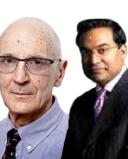Stress
A Surprising Approach for Coping With COVID-19 Stress
Has psychology been thinking about stress in the wrong way up until now?
Posted October 22, 2020 Reviewed by Ekua Hagan

Animals do not worry.
In that simple, perhaps controversial, statement lies the secret to coping with COVID.
The "animals do not worry" line comes from a revolutionary paper recently published in the Journal of Anxiety Disorders which suggests mental health experts have been "barking up the wrong tree" when it comes to advising the public on how to cope with COVID.
Animals do experience stress, and this occurs, just as in humans, when they find themselves in danger. The fear or anxiety response, genetically built into our bodies, is evolutionarily ancient.
Even though it renders us upset, it’s designed to ensure we remain vigilant for danger, and so stay safe, and therefore alive. Panic meant we got away, fast, when a lion started bounding towards us, as ancient cavemen.
But wildlife doesn’t stalk us in modern life, instead, we confront social threat; a bullying boss, unemployment, social isolation, or marital discord.
Yet all these predicaments still trigger the ancient "fight or flight" escape response to physical peril. Escape from a bullying boss, or a virus, is no longer as simple as bolting, (though we wish it were).
Now a radically new theory about the fundamental nature of stress, pioneered by psychologists Jos Brosschot and Bart Verkuil from Leiden University in the Netherlands, and Julian Thayer from the University of California, Irvine, argues we have all been looking in the wrong place for mental health.
According to these psychologists, the essential question is not why we get anxious when the world becomes dangerous, but instead, the key dilemma is recognising what safety looks like.
This revolutionary new way of thinking is particularly relevant to coping with COVID-19. The pandemic has turned many ordinary aspects of life into new dangers, such as everyday physical contact and normal socialising. Ordinary activities such as going to school or work or commuting have now become apparently hazardous. Even if you try to avoid the threat by staying at home, new risks emerge in the form of social isolation, losing your job, and the impact of an obliterated economy.
Nowhere seems safe, triggering our ancient threat detection anxiety system within our brains, leading to chronic stress.
Jos Brosschot, Bart Verkuil, and Julian Thayer argue we have developed a generalized perception of "unsafety."
If your boss has begun bullying you at work then their mere presence signals danger, so you become stressed, even when the boss is not actually tormenting you, but just saying hello. Your brain starts viewing the entire office as a place of danger, generalising to commuting to work (so the train makes you sick to your stomach), finally just thinking about anything which is linked to your job becomes a trigger for worry. Eventually, everything becomes an indicator you are not in a place of safety, no matter where you are.
Jos Brosschot, Bart Verkuil, and Julian Thayer label their new theory; “Generalized Unsafety Theory of Stress” or GUTS, suggesting that not being able to switch off the worry response is the key issue, because stress spills over into objectively safe places and times
This essential difference between us and animals; they get anxious, but they don’t worry, holds the secret to mental health. Rumination transforms relatively safe situations into unsafe predicaments.
So, the central question for mental health survival we all need to ask ourselves, is what does true safety look like? The answer will differ from person to person, but it is the inability to identify safety, and learning to inhabit it, which explains chronic stress. Safety could be a location, perhaps a lifeboat after the Titanic went down, or under the duvet as a refuge from a brutal world, or it can be a mental place, meditation, or watching a distracting movie or being absorbed by a hobby or sport.
The key point is, we need to find and inhabit places of mental or physical safety, know where they are, and go to them, once we can do no more problem-solving.
For survival reasons the stress response is always there, lurking in the background, on the verge of being activated, only being properly switched off when safety is clearly apparent. As long as there is no clear proof of safety, insecurity remains, and the default stress response remains "on."
What has to be learnt as we grow and develop is what safety looks like.
Ever-evolving uncertainty about the future, given a mutating virus, swings in Government policy and Public Health advice; means the goalposts keep shifting over what is, or what is not, alarming, during the pandemic. Intolerance of uncertainty underpins panic during this crisis.
Experimental psychologists discovered a long time ago that it was not so much electric shocks that damaged us mentally, but instead, it was administering unpredictable punishment. We can learn to cope with even the most difficult predicaments, as long as we know they are coming.
The stress-reducing effect of predictability hinges on recognizing safe periods between traumas. In other words, once animals or humans appreciated when no harm would happen, they found it easier to cope with shocks. Unpredictability undermined this, and if adversity could occur anytime, then even the duration between disturbances had become unsafe.
Most stress does not occur in actual emergencies but during the periods in between traumatic events.
Jos Brosschot, Bart Verkuil, and Julian Thayer point out in their paper that is vital to recall that before the pandemic, stress was also unavoidable in life. Even those with superior coping skills have to confront the reality that there are always threats coming over the horizon. Disease nor pain cannot be abolished; misfortune will keep threatening us incessantly. The vicious boss is unlikely to change, just as lions will always be present in the life of antelopes.
There is no vaccine for life.
To maintain good mental health, it is therefore vital to restrict our stress responses to episodes in which bad events actually happen. The secret is to create as many safe periods as possible, even if this is something we need to do in our heads.
As a metaphor, the authors cite the example of the antelope that never runs further away from the lion (the ever-present stressor) than necessary to allow for adequate time to easily escape from the next attack: the safe zone.
Exactly because most stressors are an inevitable part of life and will "never become safe," it is paramount to learn where and when life is safe, and thus to learn where and when to find safe periods/safety zones.
“What triggers anxiety?” is the wrong question. The stress response, from an evolutionary perspective, is built into us to help us survive a dangerous environment.
Instead, a better question is: “What stops stress?”
The answer is safety. Even if it is merely perceived shelter.
Stress is not due to the presence of something (the virus, job loss, social isolation), but instead the lack of something else: safety. Animals don’t worry; they are biologically programmed to seek sanctuary and then know when they have found it.
This is why animals are so territorial. We can learn from them to find secure territory too.
Similarly, we need to find and create refuge the best way we can, because the world is not menacing all the time, even though our bodies, and our leaders, appear to believe it is.
Dr. Peter Bruggen passed away in 2018. While this post was written by Dr. Raj Persaud, Dr. Bruggen's name is retained biographically as a tribute to his contributions overall.
References
Jos Brosschot, Bart Verkuil and Julian Thayer, The default response to uncertainty and the importance of perceived safety in anxiety and stress: An evolution-theoretical perspective. Journal of Anxiety Disorders Volume 41, June 2016, Pages 22-34




